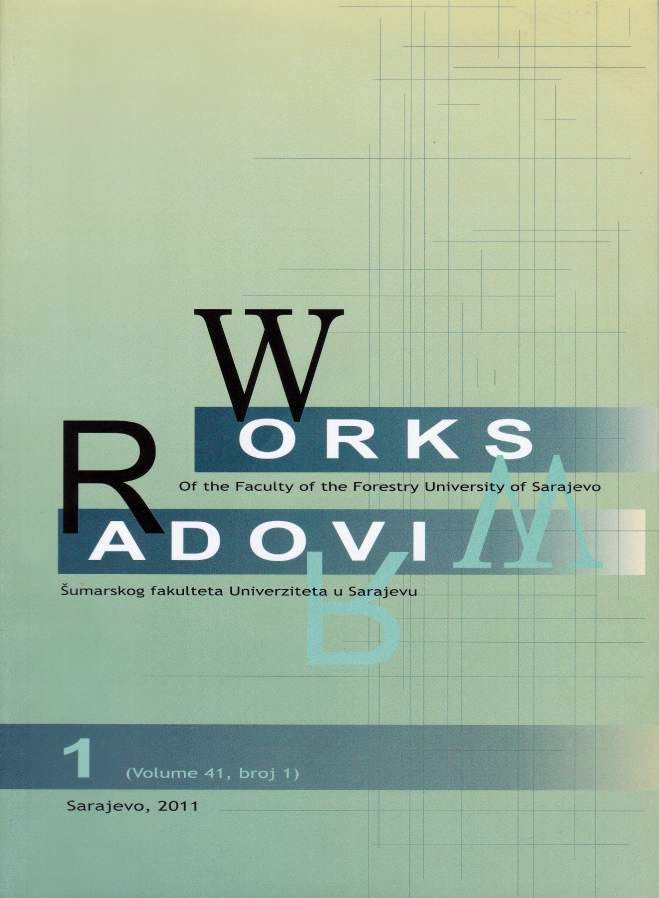Secondary forest roads network on the steep terrain
DOI:
https://doi.org/10.54652/rsf.2011.v41.i1.141Keywords:
tractor road, longitudinal slope, timber skidding costsAbstract
UDK 630*38
The impact of the longitudinal inclination of tractor roads on openness of forest compartments has been analyzed in the compartment 7 of Management unit "Crna Rijeka". This area has been characterized by the terrain inclination of 52,45 %; existing openness by secondary network is 24.89 m/ ha.
This paper describes several variants of tractor roads with inclination of 15, 17, 19 and 21 % for opening of forest compartment 7. The altitudes of the terrain of starting and ending points of designed tractor roads for all longitudinal inclinations of tractor roads were same. After a survey analysis it has been calculated that increasing of inclination of tractor roads causes decreasing of total length of tractor roads, i.e. the length of 4732.74 m corresponding to inclination 15 % has been decreased to 3381,02 m which has been measured for longitudinal inclination of 21 %. Also, increasing of longitudinal inclination of tractor roads from 53,30 m/ha for longitudinal inclination of 15 % to 38,07 m/ha measured for tractor roads for longitudinal inclination of 21 %. The survey analysis has shown that the construction cost of tractor roads with longitudinal inclination of 15 % is 48794,55 KM and the construction cost of tractor roads with longitudinal inclination of 21 % is 34858,32 KM. The result obtained in this paper gives numerical indicators of the impact of longitudinal inclination of tractor roads on area openness, mean transport skidding distance and construction costs of tractor roads.
In this paper the importance of longitudinal inclination of tractor roads for development of erosion processes has been emphasized. This has to be particularly taken into account for high longitudinal inclinations and low carrying geologic- pedologic terrains.
Downloads
References
BAJRIĆ, M., 2005: Mogućnost konverzije glavnih traktorskih puteva nagiba do 12 % u prilazne kamionske puteve, Magistarski rad, Šumarski fakultet, Sarajevo.
DOBRE, A., 1987: Izgradnja šumskih puteva u predjelima gdje se primjenjuju žičare, Mehanizacija šumarstva, 3-4 Zagreb
JELIČIĆ, V., 1983: Otvaranje šuma primarnom i sekundarnom mrežom šumskih puteva, Mehanizacija šumarstva, 8,11-12, Zagreb, str.1-192.
JELIČIĆ, V., 1983: Šumske ceste i putevi, skripta, Zagreb.
JELIČIĆ, V., 1985: Studija otvaranja odjela 70 i 71 u GJ „Jadovnik – Drvar“ dio, Sarajevo
KULUŠIĆ, B., 2003: Iskorištavanje šuma – manuskript.
PIČMAN, D., & PENTEK, T., 1996: Utjecaj uzdužnoga nagiba traktorskih vlaka na otvorenost odjela, Zaštita šuma i pridobivanje drva, Zagreb.
Pravilnik o gozdnih prometnicah, Uradni list Republike Slovenije RS 104/2004
ROBEK, R., & MEDVED M., 2001:, Implementation of cable logging requirements in environmentally sound road construction. FAO - Workshop proceedings new trends in wood harvesting with cable systems for sustainable forest management in the moutains. Ossiach, Austria.
SOKOLOVIĆ, DŽ., 2008: Uticaji nagiba terena na pravilan izbor vrste šumskog transportnog sredstva, Disertacija, Šumarski fakultet, Sarajevo






















